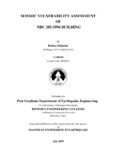Please use this identifier to cite or link to this item:
https://elibrary.khec.edu.np:8080/handle/123456789/505| Title: | SEISMIC VULNERABILITY ASSESSMENT OF NBC 205:1994 BUILDING |
| Authors: | Shilpakar, Roshan |
| Advisor: | Er. CHANDRA KIRAN KAWAN, Dr. MANJIP SHAKYA |
| Keywords: | Fragility curve, Inter-storey drift ratio, Non-linear time history analysis |
| Issue Date: | Jul-2019 |
| College Name: | Khwopa Engineering College |
| Level: | Masters |
| Degree: | ME Earthquake |
| Abstract: | Reinforced concrete buildings constitute the predominant type of construction in urban areas of Nepal. Mostly these buildings are infilled with masonry wall for architectural or functional purposes. However, these RC buildings are often analyzed by considering that these infill panel will not resist any kind of load i.e. vertical or lateral load. The present thesis presents the seismic vulnerability assessment of RC building constructed based on the NBC 205:1994 guideline and investigate the influence of masonry infill wall in the performance of the reinforced concrete (RC) frames. Representative RC building models (bare frame) based on the NBC 205:1994 guideline is considered for the study. Furthermore, three additional models were created based on different disposition of the infill wall in order to consider the effect of masonry infill wall in the seismic performance of the building. Vulnerability assessment was carried out using the analytical fragility curve, which is the graphical representation of the seismic risk of a structure. For the development of fragility curve, non-linear dynamic time-history analysis was carried out through SeismoStruct Software. Fragility curves were developed based on the results of time-history analysis considering seven damage states slight, light, moderate, extensive, partial collapse and collapse as proposed by T. Rossetto (2003) based on threshold inter-storey drift ratio. Results indicated that infill enhanced the stiffness and lowered the expected responses during earthquakes. It was observed that infill could favorably influence the seismic response by increase of strength, and stiffness and lowering of the inter-storey drift ratio thus lowering damage probability, provided that they are placed regularly throughout the structure and that they do not cause shear failures of columns. |
| URI: | https://elibrary.khec.edu.np/handle/123456789/505 |
| Appears in Collections: | Master of Science (M.Sc) in Earthquake engineering |
Files in This Item:
| File | Description | Size | Format | |
|---|---|---|---|---|
| Roshan_Silpakar_2013.pdf Restricted Access | 1.36 MB | Adobe PDF |  View/Open Request a copy |
Items in DSpace are protected by copyright, with all rights reserved, unless otherwise indicated.
